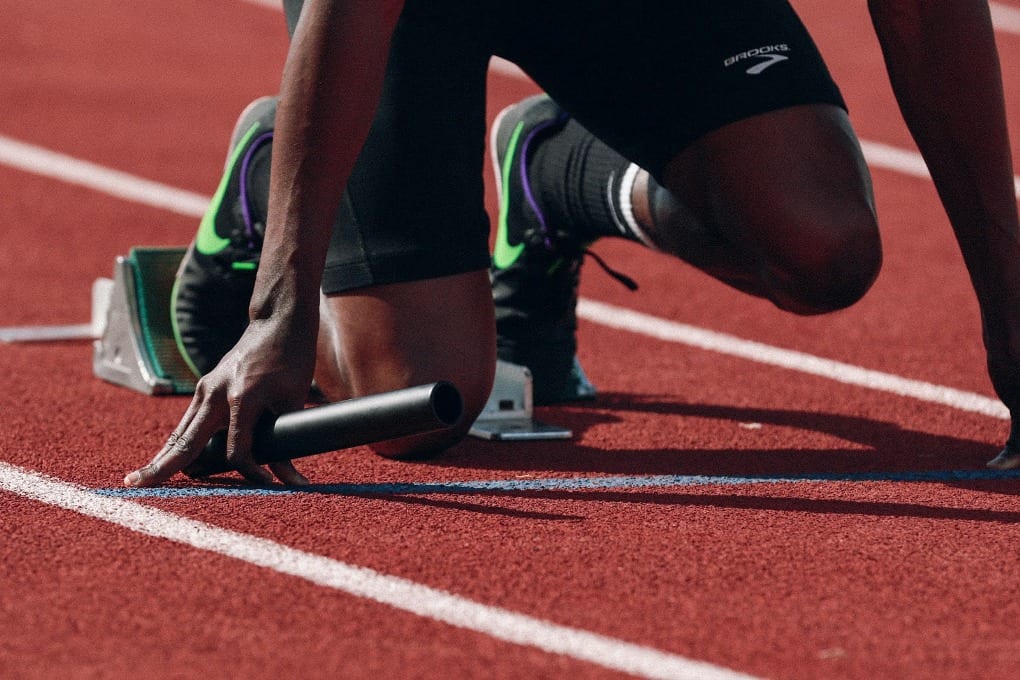If you have a keen interest in sports and medicine, you might be wondering: What is a sports medicine degree? With a sports medicine degree, you can treat sports injuries and help athletes reduce their pain.
These injuries will usually be musculoskeletal injuries, like sprains and strains, joint dislocations, and simple fractures. Then there are more chronic issues like tendonitis, arthritis, and trauma to the brain, such as concussions.
This article will explore what you can do with a degree in sports medicine, the salary for those careers, and how to get into sports medicine.
What Is Sports Medicine?

Sports medicine is for someone looking to help athletes prevent injuries and treat those who have suffered an injury. Professionals working in sports medicine can directly work with athletes at games and competitions, but can also help regular patients who are physically active.
There are many different sectors you can go into with a sports medicine degree, all centered around helping a patient’s mobility, reducing pain, and building strength.
Careers With a Sports Medicine Degree
Here are some of the potential careers you can pursue with a sports medicine degree.
Physical Therapist
A physical therapist helps patients with exercise plans to aid recovery from muscle, joint, and nerve injuries. They usually take a physician’s diagnosis and then work to create a therapy plan best suited for the patient. To be a physical therapist, you will need a bachelor’s degree, a doctor of physical therapy degree, and a license.
Athletic Trainer
As an athletic trainer, you will be supporting an athlete or athletic team to ensure top athletic performance. You will be outlining nutrition plans, safe and effective exercise routines, and you will help prevent injury and help with recovery.
To be an athletic trainer, you need an athletic training bachelor’s or master’s degree and must pass a board certification exam in athletic training.
Orthopedic Surgeon
An orthopedist works both surgically and non-surgically to treat muscle, tendon, joint, and bone afflictions. To be an orthopedic surgeon, you will need a bachelor’s degree, a doctor of medicine degree, and an orthopedic surgery residency (four to five years).
Primary Care Sports Medicine Physician
A primary care sports medicine physician works alongside physical therapists and other healthcare providers to diagnose and treat injuries. They can help athletes and non-athletes by recommending nutrition plans and athletic conditioning.
You will need a bachelor’s degree, a doctor of medicine degree, a family medicine specialty, and a non-degree certification in sports medicine.
Sports Medicine Nurse
A sports medicine nurse helps the physician by co-designing treatment plans and relaying information about the patient’s recovery to them. To become a sports medicine nurse, you will need a nursing bachelor’s degree, possibly a nurse practitioner master’s degree, and then Orthopedic Nursing Certification.
Essential Sports Medicine Practitioner Skills
Patient Rapport
Your written and oral communication skills will be invaluable when working with your patients. If you have a keen interest in sports, that will further help you talk to your patients about their fitness goals. Most of all, a sense of compassion for athletes or amateur athletes will go a long way in delivering the best care possible.
Knowledge of The Body
Much like a doctor or surgeon, you will need to study anatomy. If you find yourself fascinated by biology, chemistry, and anatomy, then this could be the perfect career.
Treatment Planning
A big part of your role will be creating treatment plans for your patients. This could include an exercise plan for injury prevention, a nutritional plan for optimal athlete performance, or a therapy plan for restoring wellness in the patient’s body post-injury.
Sports Medicine Salaries and Job Outlook

Your salary as a sports medicine specialist can depend on a lot of factors, such as what specialty you choose, your years of study, and how many years you’ve worked. Below is an overview of some healthcare sectors and their average salary per year, according to the US Bureau of Labor Statistics and Salary.com.
- Physical Therapist: Average annual salary was $89,440 in 2019
- Athletic Trainer: Average annual pay was $48,440 in 2019
- Orthopedic Surgeon: Annual pay is $490,330 in 2020
- Primary Care Sports Physician: Average annual salary was $181,250 in 2019
- Sports Medicine Nurse: Average annual salary was $47,480 in 2019
Sports medicine careers are projected to grow 11 percent in the next 10 years, according to the Bureau of Labor Statistics, which is above average. Of course, it depends on the specialty, but this is still great news for those who are interested in sports medicine.
How to Become a Primary Care Sports Physician: A Step by Step Guide

In this step-by-step guide, we will focus on how to become a sports physician. The total time it takes from your undergraduate degree to your first job as a licensed sports physician is around 12 to 13 years.
Step 1: College Degree in Pre-Med – 4 years
This is where you will gain an undergraduate degree that will prepare you for your medical degree. Make sure to pick a college that has a curriculum that meets the standards for medical school and prepares you for the MCATS (renowned as the most challenging professional exam out there). The things you will likely be studying in your pre-med are:
- Biology
- Anatomy
- Chemistry
Step 2: MCAT Exam
The MCAT is your Medical College Admission Test. As your pre-medical degree comes to an end, you will take the MCAT exam to give you time to apply for medical school.
Make sure to use the free materials that the Association of American Medical Colleges (AAMC) has in preparation for this exam.
Step 3: Medical School (graduate degree) – 4 Years
This is a tricky choice as all medical schools are different; some focus on medical technology and others range from practical knowledge to purely academic studies. Here, you will be getting your Doctor of Medicine degree or a Doctor of Osteopathic Medicine degree.
Which one you choose depends on you, what scholarships are available to you (if needed), and whether they have a primary specialization of either orthopedic surgery or primary care, with a sub-specialty in sports medicine.
The last two years of your medical school will be a clinical rotation. This is where you will get to interact with patients, provide patient care, and get some hands-on training in various fields of medicine.
Step 4: Residency – 3 Years
With residency, none focus on sports medicine, but rotations can include sports medicine treatments. Look to do a residency in family medicine, emergency medicine, internal medicine, pediatrics, neuromusculoskeletal, or rehabilitation medicine.
If you want to take the surgical route, then do your residency in orthopedic surgery medicine.

"Career Karma entered my life when I needed it most and quickly helped me match with a bootcamp. Two months after graduating, I found my dream job that aligned with my values and goals in life!"
Venus, Software Engineer at Rockbot
Step 5: Sports Medicine Program/ Fellowship – 1 to 2 Years
Those looking to become a primary care sports physician will then do a one- to two-year fellowship in sports medicine.
Here you will work with a local high school or college sports team to learn more about sports injuries while completing further studies on your chosen specialty (i.e. family medicine or pediatrics).
If you are pursuing a career in orthopedic surgery, it is best to do your fellowship in surgical sports medicine.
Best Sports Medicine Degree Programs and Schools
Searching for the right sports medicine degree program and school can be a lengthy and complicated process. Of course, the decision should always be based on further research, your career goals, and what works best for you and your circumstances.
Below are some recommended graduate schools based on Study.com, which has a list of some of the best schools for sports medicine, as well as other guides and information on different levels of education.
- University of Virginia
- University of North Carolina
- University of Miami
- University of Georgia
- Ohio State University
- Utah State University
What influences these school rankings is affordability, student retention rates, graduate salaries, and overall reputation. Check their website and also check topuniversities.com for its list of top medical schools as you complete your research.
Should You Pursue a Sports Medicine Degree in 2020?
Sadly due to COVID-19 and the cancellation of many sporting activities, this is a difficult question to answer. Like most careers, sports medicine is having to adapt to new changes and find ways to practice in the community safely.
Although it may take a while to adapt to sporting events and be able to work with athletes, there will always be a need to help with musculoskeletal issues. So, if you have a real passion for helping people with such injuries then it may be worth it, especially with such good career prospects over the next 10 years.
Sports Medicine FAQ
It depends on whether the injury is surgical or not. If it seems like it is definitely surgical, then seeing an orthopedic surgeon first is fine (if your insurance allows it). And if it seems like a common fracture or injury, then a primary care sports physician is the first go-to as they can also refer patients to an orthopedic surgeon if surgery is required.
No, these are thought of as equivalent degrees. However, a Doctor of Osteopathic Medicine is more focused on things like manipulation of the body and musculoskeletal injuries.
Yes. You will need to do the Certificate of Added Qualifications (CAQ) in Sports Medicine. Make sure they are accredited by the American Board of Medical Specialties (AMBS) or the American Osteopathic Association (AOA) Bureau of Osteopathic Specialists.
No. The fellowship is required to do the examination.
About us: Career Karma is a platform designed to help job seekers find, research, and connect with job training programs to advance their careers. Learn about the CK publication.



